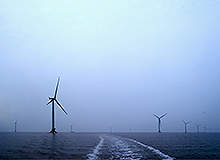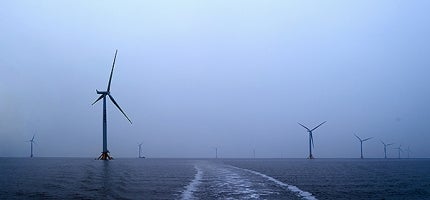

The Jiangsu Rudong offshore wind farm, with an installed capacity of 150MW, was China’s biggest offshore wind farm at the time of opening in 2012. The project, which is located 3km to 8km off the coast of Rudong district in the East China Sea, began commercial production in November 2012.
Built by Jiangsu Longyuan Offshore Wind Power, a subsidiary of China Longyuan Power Group, it is also the nation’s first offshore demonstration project for generating wind power in intertidal zone.
The project was built in two phases from 2011 to 2012 at an estimated cost of CNY 2.32bn ($397m). Construction on the 100MW first phase began in June 2011 and was completed by the end of 2011, while the second phase, with an installed capacity of 50MW, was completed in the fourth quarter of 2012.
Annually, the offshore wind farm produces up to 375 million kilowatt hours (kWh) of renewable power and offsets 247,000t of carbon dioxide emissions.
History of the Jiangsu Rudong offshore wind farm
The National Development and Reform Commission of China gained the confidence to approve the project based on the benefits demonstrated by a 32MW Offshore Pilot Wind Farm off the coast of Rudong.
The offshore wind farm was built much quicker than the pilot project, becoming fully connected to the grid in September 2012.
Location and make-up
The wind farm is located approximately 250km north-east of Shanghai, which is dried up at low tides but covered by up to 5m of water at high tide. A shallow water zone and good wind conditions were reasons behind this decision.
The first phase comprises 21 Siemens 2.38MW wind turbines and 17 Sinovel 3MW turbines, while the second phase comprises 20 Goldwind 2.5MW turbines with rotor diameter of 100m. The Siemens turbines have a rotor diameter of 101m and are supported by multi-jacket foundations, while the Sinovel turbines have a rotor diameter of 90m.
Both the Sinovel and Goldwind turbines are supported by monopile foundations.
Construction of the project
The location posed construction challenges because of the high tide environment. The offshore construction equipment had to be carried in a barge which was moved in the waters during tide rising and stopped for equipment installation after the tide fell.
Offshore construction equipment was supplied by Jiangsu Longyuan Zhenhua Marine Engineering. It included more than 20 special ships for various purposes such as cabling, disanchoring, lifting, and transporting. A special flat-bottom barge was also built.
The turbine foundations were built using the single-pipe pile driving method.
Offshore wind power in China
Wind power is China’s third biggest energy source accounting for 1.5% of electricity generated in the nation, and is believed to have far-reaching potential for the country. It is followed by thermal and hydropower. China aims to achieve 100GW of gross installed wind power by 2015, but had just two offshore wind farms at the beginning of 2013.
The country plans to increase the installed capacity in offshore wind power in the future, as witnessed by its National Energy Policy that requires 5GW of offshore wind power capacity by 2015 and 30GW by 2030.
However, the chances of achieving the 2015 goal look bleak as the country’s total installed capacity is less than half a gigawatt as of early 2014.


